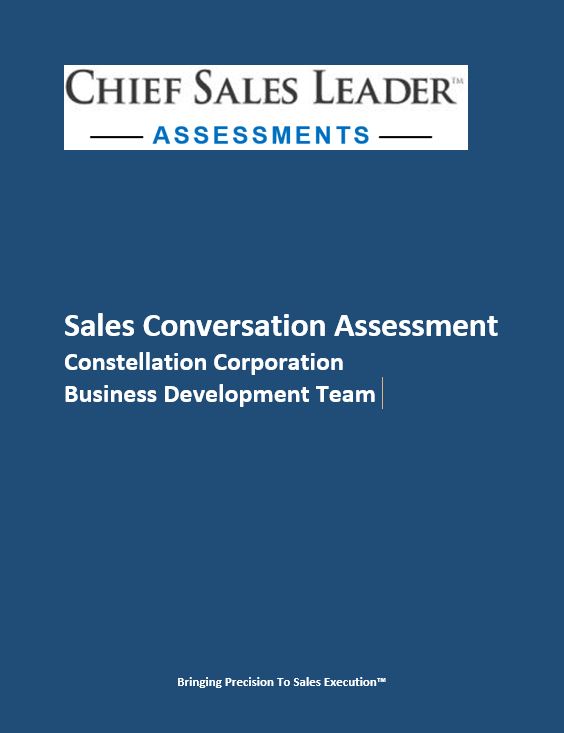Maintenance Services
Why Assess Your Sales Conversation Approach?
If your salespeople are doing one or more of the following things during sales conversations then it’s time to assess your approach.
- Jumping from topic-to-topic and point-to-point.
- Over-explaining (talking too much) or under explain things.
- Forgetting what to say and not to say.
- Prematurely ending sales conversations to find answers.
- Over or understating company capabilities.
- Using jargon, buzzwords, and language that confuses buyers.
- Becoming confused when buyers change the subject.
- Paying limited attention to what buyers are saying.
- Frequently losing their place in conversations with buyers.
- Using sales presentations that confuse buyers.
What Does The Assessment Look For?
The assessment is built around two key assumptions:
- The goal of a sales conversation is to reach shared understandings and agreements that preferably result in
the buyer purchasing. - To reach shared understandings and agreements the buyer and seller exchange information (see graphic).
So, the assessment evaluates the ten key tasks performed by salespeople during the exchange of information with buyers.
What Does The Assessment Evaluate?
The assessment evaluates the level of precision with which salespeople execute ten key tasks during the exchange of information with buyers during sales conversations:
- Get and keep the buyer on the same page throughout all stages of the sales conversation
- Validate assumptions about what buyers a) know and don’t know about the seller’s company, offerings, and differentiation, b) value when determining if a vendor/partner is worthy of doing business with, and c) want to discuss now versus later.
- Sequence and accurately present the right questions and answer options at the right time to: a) understand the buyer’s situation, b) define and prioritize buyer problems, wants, and needs, c) clarify the impact the problems are having, and d) establish an economic reason for solving the problem.
- Answer questions about products, services, applications, and competitors that buyers know to ask and don’t know to ask.
- Access and share information including a) presentations, b) demonstrations and comparisons, c) pricing and discounts, d) case studies and testimonials, and e) product and service information sheets.
- Present recommendations and proposals including a) preparing solution options, b) pricing and discounts, and c) terms and conditions.
- Test buyers at each stage of the exchange of information for understanding and agreement.
- Switch roles between a) talking, viewing, and listening, b) interpreting and preparing responses, c) searching for information and documents,
- Mitigate differences with buyers including a) frames of reference and assumptions, b) language and terminology, c) knowledge and experience, d) the timing of decisions, e) personal agendas and priorities, and f) personality styles.
- Remember to apply a) selling skills and methods, b) company policies and procedures, c) best practices, and d) legal compliance measures.


Sales Conversation Assessment
We Provide You With:
- Briefings on the Chief Sales Leaders Sales Conversation Framework™
- An Online Self-Assessment that is quick to complete
- Focus Group Assessments to dig deeper into and clarify problem areas
- One-on-One Interviews to uncover hidden truths and agendas
- Document Assessment to determine if they exist, are complete and are used
- Report on priorities and recommendations
How Does The Sales Conversation Assessment Work?

Step 1 – Complete The Online Assessment
To gain insight from one or all of the following sources:
- Salespeople
- Sales Manager(s)
- Peers in other departments
- Executives
- All the above
Step 2 – Conduct Interviews
To clarify insight gained from the online assessment from one or all of the following sources:
- Salespeople
- Sales Manager(s)
- Peers in other departments
- Executives
- All the above


Step 3 – Conduct Focus Groups
To clarify insight gained from the online assessment – – from one or all of the following sources:
- Salespeople
- Sales Manager(s)
- Peers in other departments
- Executives
- All the above
Step 4 – Conduct Document Review
To clarify insight gained from the online assessment – – from one or all of the following documents:
- Training materials
- Sales call recordings
- Sales playbooks, FAQs, and Wiki’s
- Sales presentation libraries
- Sales scripts
- Sales proposal libraries


Step 5 – Assessment Report
- Outline of strengths and weaknesses
- Prioritization of improvement areas
- Recommendations for process improvement


